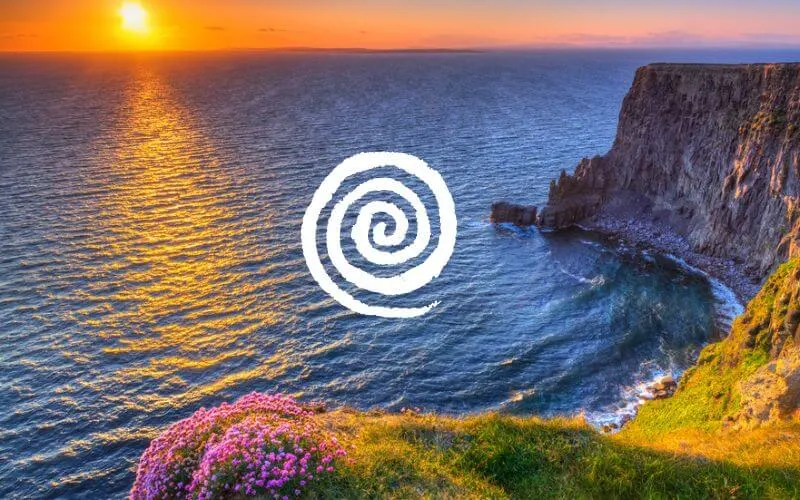
Table of Contents
Celtic Symbols and their Meanings
The Celtic Revival in the mid-19th century sparked people’s interest in Celtic Culture, Celtic mythology, and of course Celtic symbols.
It is undeniable that the Celts have left a lasting impression on many different cultures across Europe, least of all Ireland.
One important point that must be clarified is that Celtic symbols are often mistakenly thought of as symbols of Ireland and its culture. This is simply not the case.
What is the difference between Celtic Symbols and Irish symbols?
Celtic symbols are older than Irish symbols.
The origin of Irish Celtic symbols date back to the Celtic tribes who first settled in Ireland about 500 BCE. These people left an impressive cultural artistic legacy through their design and artwork, not only in Ireland, but also areas of Europe as well.
Symbols, like the Irish harp, the shamrock and the leprechaun have evolved associations with the Emerald Isle, Irish people and Irish culture in more recent times after the existence of the Celts.
If you want to read about Celtic Knots, then our article is a great place to start.
Celtic Symbols
The Celts were highly skilled crafts people, who have left a remarkable legacy of artwork in their wake.
Their Celtic symbols may have originated, or at least been in part inspired by the artwork of the older Neolithic period.
(If you would like a quick recap about who the Celts were and the origins of their artwork and designs read the FAQ at the end of this post).
List of Celtic Symbols:
- Celtic Spirals
- Triskelion or Triskele
- Celtic Knots
- Triquetra or Trinity Knot
- Celtic Tree of Life
So-called Celtic Symbols
- Celtic Cross
- Spiral of Life
- Awen
Spirals
Spirals are one of the most ancient symbols and have developed in several cultures across the globe.
In fact, some of the oldest examples of spirals in the world have been discovered in Ireland.
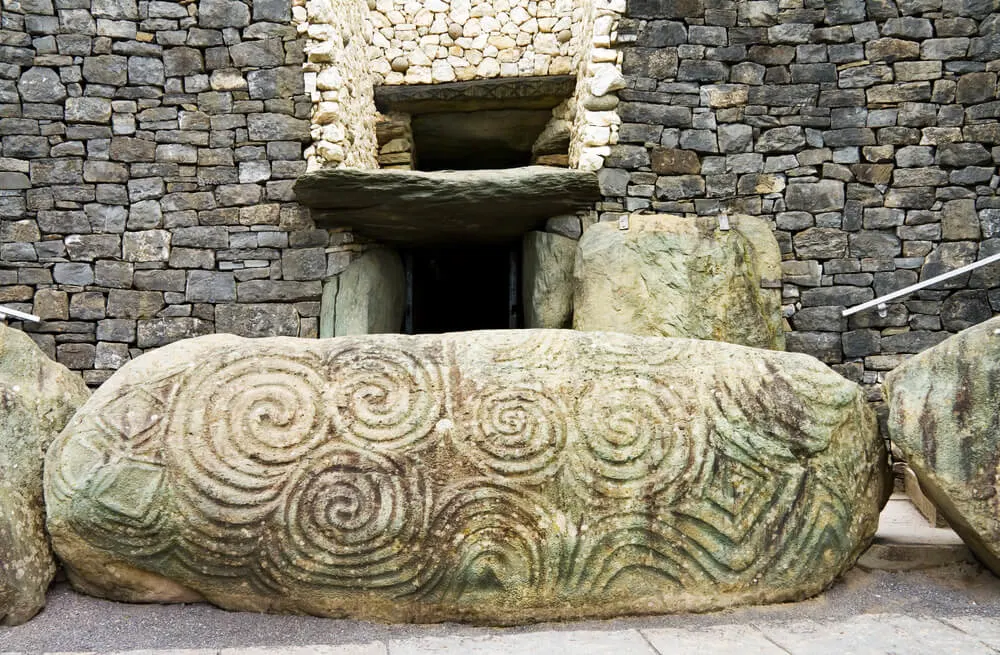
These are found in the Neolithic artwork of the Newgrange burial tomb in County Meath, Ireland from about 3200 BCE (and predate the Pyramids).
The Celts only arrived in Ireland about 500 BCE, so these spiral design symbols predate them.
Types of Spirals and their Meanings
Spirals are a common feature of Celtic art and there are a number of different kinds.
Please be aware that spirals in Celtic art should not be confused with the term “Celtic Spirals”, which often refers to the triple spiral symbol of the Triskelion or Triskele.
As with all Celtic signs, deciphering the exact meaning is difficult as there are no written records.
Based on the research of scholars in the field, there are solid interpretations as to what they might symbolize.
Single Spiral

An anti-clockwise spiral is thought to symbolize the passage from the inner self to the outer soul.
This Celtic single spiral is thought to show the development, or growth of a person over time and maybe connected with cosmic energy.
These single spirals have been most commonly found on archaeological burial sites and on dolmens in Ireland and France.
Clockwise Single Spiral
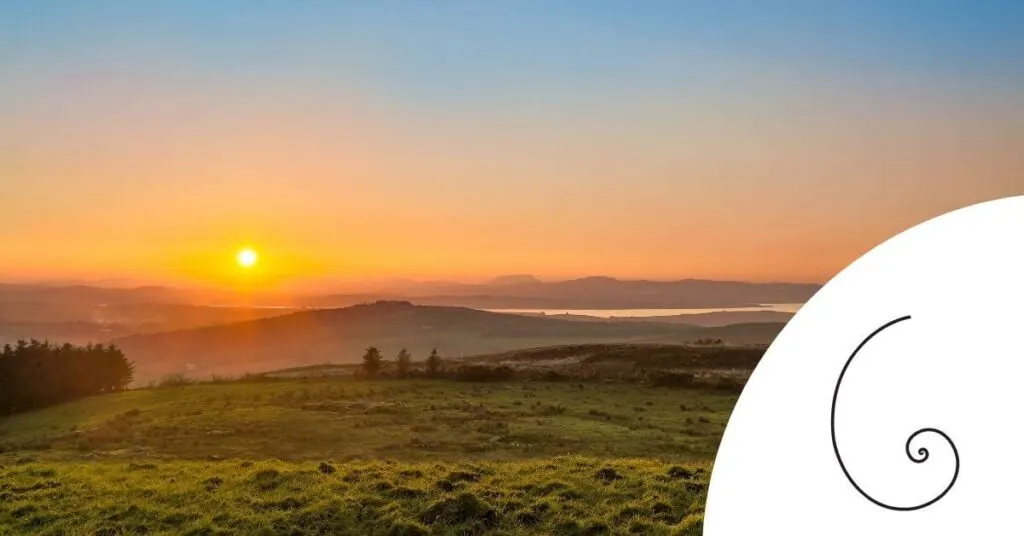
(Photo: © Barra O’ Meiscill, symbol: © Artischok both via Canva)
A loose right-winding spiral has been commonly associated with the element of water.
While there is no Celtic symbol for power, this might be one of the closest representations.
It is also somewhat connected with independent movement and tribal migration.
Double Spiral
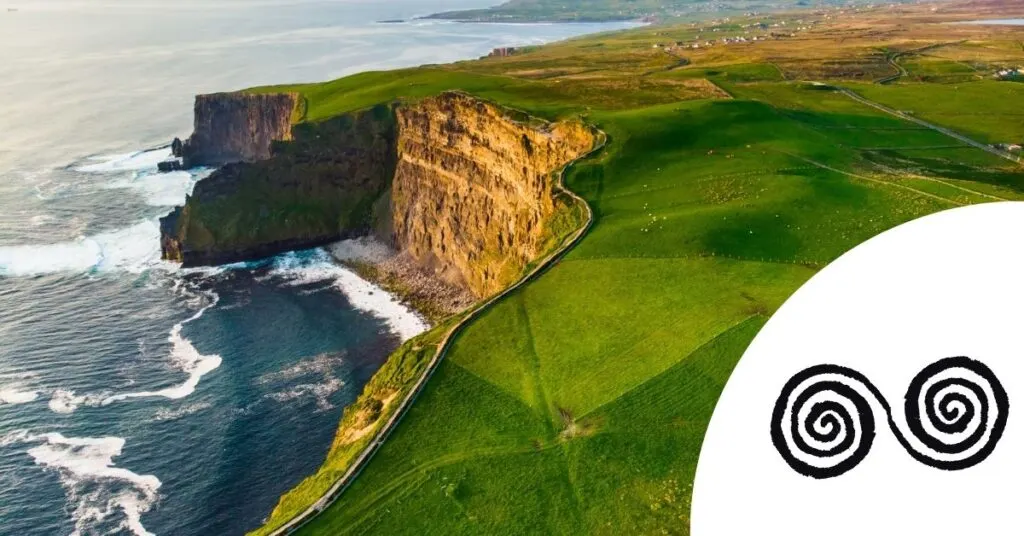
By combining two single spirals the double spiral is formed. The spirals are not a mirror image of each other, but rather wind in different directions.
The double spiral can be seen as a symbol of becoming and traversing from one point to another.
The spiral starts in one direction (clockwise) and changes direction (anti-clockwise) while still moving forward.
As well as being symbolic, the double spiral is often used for decorative purposes in Celtic art.
Double Centred Spiral

The double centered spiral is a more elaborate symbol that is thought to symbolize the moon, as well as the number two.
It is also thought to stand for balance and harmony through the two-foldedness of nature.
This book is a useful source to find out more about spirals. It is an in-depth, academic reference book, which provides brief, but thorough background to Celtic Spirals, as well as the significance of spirals in many other aspects across the world.
Celtic Knots
Celtic knots are one of the most recognisable of all Celtic symbols. (Read here for a detailed overview about Celtic Knots)
Due to the appearance of similar knots, such as in floor mosaics from the late Roman period and early Byzantine Empire artwork in the 4th century, it can be difficult to exactly date the origins of Celtic knots.
Prior to the arrival of Christianity in Ireland in about the 5th Century, Celtic art generally consisted of patterns of spirals, lozenges and other geometric designs.
From roughly about 600 CE, Celtic knots became a regular feature of Insular art (or Hiberno-Saxon art) that developed in Britain and Ireland around this time.
The artwork from this period tends to focus on linear patterns incorporating loops and braiding of one continuous line to create complex spatial designs.
What are Celtic Knots?
Celtic knots consist of an interlaced pattern of loops that are without a beginning or end.
They are commonly seen in illuminated manuscripts, metalwork and stone carving throughout Ireland from about the 7th-12th century.
What do Celtic Knots Symbolize?
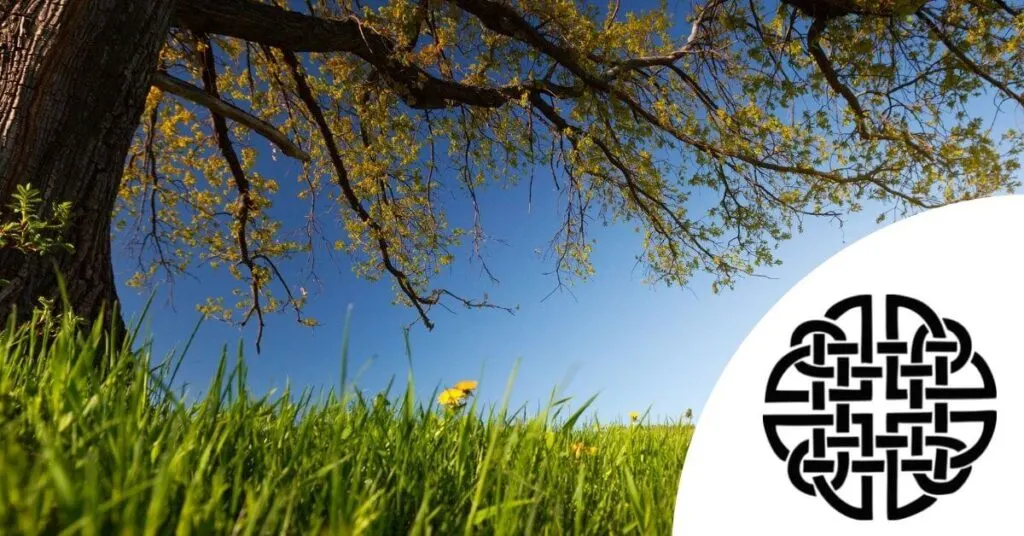
(Photo: © mihtiander, symbol: © 35393 both via Canva)
The endless nature of a Celtic knot without a start or finish point is thought to symbolize eternity and unity.
This symbol is particularly well aligned with the popular representations of everlasting love, friendship and loyalty.
However, due to the largely oral tradition of the Celts, Celtic knot meaning and the exact origins have been left open to scholarly interpretation.
Popular Types of Celtic Knots and Celtic Patterns
There are several different Celtic Knots and Celtic patterns.
These patterns of knot Celtic design work would have been used on decorative manuscripts, as well as stone carvings and metalwork design.
Today, many are often incorporated into Celtic jewelry designs.
List of Celtic Knots:
- Celtic Spiral Knot or Triskelion
- Celtic Trinity knot
- Celtic Love Knot or Serch bythol
- Celtic Sailors Knot
- Dara Knot
- Celtic Shield knot
- Celtic Motherhood Knot
Celtic Knotwork interlace, Celtic spirals, step patterns and basic knot patterns form some of the basis for Celtic patterns and Celtic knot pattern designs.
Triskelion
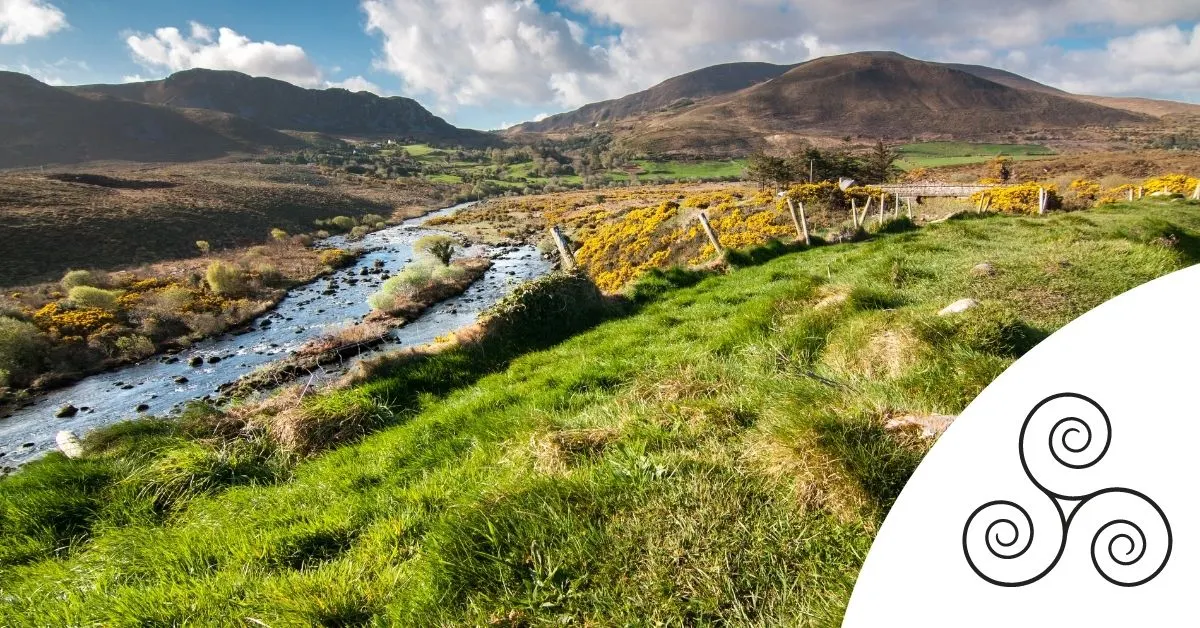
The Triskelion, Triskele or threefold spiral is an ancient symbol which features an interlocked triple spiral.
It can appear that the symbol has three legs, which is where the Greek origin of the word “Triskele” stems from.
Although the word Triskele is older in origin, the Triskelion is commonly used.
Triskelion is the diminutive form of the word and had its first appearance only in the 19th century.
The Triskelion Origin
It is worth noting although this is considered to be one of the ancient Celtic symbols, the Celts were not the first people to use it.
Similar designs have been found in Malta, as well as in the Neolithic burial tomb of Newgrange in County Meath in Ireland.
The Triskelion Meaning
As all things related to the number three were held in high regard, it is likely that the Celtic Triskelion held great significance for the ancient Celts.
The Triskelion is thought to be a symbol of the druids of the Celtic culture.
There is a connectedness in this triple spiral symbol as there appears to be a motion to the outer spirals and returning flow to the inner center.
This is sometimes associated with life in the form of becoming and death at the end.
Other ideas behind the Triskelion spiral include that it stands for three distinct worlds:
- The physical world where we live
- The spiritual world home to ancestors, spirits and the gods
- The cosmic world consisting of the sun, moon, stars and other planets
Or perhaps that the Triskelion symbol represents three domains: the earth, sky and water.
Triquetra or Trinity Knot

The Triquetra or Trinity knot is the simplest knot and is composed of three interlaced arcs.
It is also sometimes known as the trefoil knot (named after the three-leafed clover or trefoil) or simply the Celtic Trinity knot.
In some designs, a circle is present either outside or weaving inside the three arcs.
This reinforces the concept of eternal life and spiritual unity associated with the knot and was likely added by Christians.
The Celts were not the only culture to use this symbol as the triquetra is also a feature of the Buddist tradition in Japan.
What does the Trinity Knot Mean?
Like most Celtic symbols, there is speculation about the original meaning of the Trinity Knot.
One popular belief behind the Trinity Knot meaning can be seen in its name. It represents the concept of the Holy Trinity in Christianity.
It contains three separate, but united parts within one symbol which aligns with the belief of the Father, Son and Holy Spirit being one.
It is highly possible that this symbol actually predates Christianity and the original Triquetra meaning as one of the Celtic pagan symbols has been lost over the course of history.
What is known though is that Celts tended to cluster important things in groups of three, for example the world around them consisted of earth, sky and water.
This is a recurring concept that can be seen in Celtic art and Celtic culture and is also seen in the Triskelion.
Modern Uses of the Trinity Knot
The Trinity knot is often seen as a symbol of the ancient culture of Ireland and is possibly the best known Irish Celtic symbol.
It frequently adorns Irish Celtic jewelry, wedding rings, ornaments and souvenirs.
Due to its endless design representing unity and eternity, the Trinity knot design has become associated with the Celtic symbol for family in modern culture.
The Celts themselves did not have specific Celtic symbols for family, but as meanings become blurred, people (and many savvy businesses) have created their own interpretations into Celtic symbols.
Celtic Tree of Life or Crann Bethadh
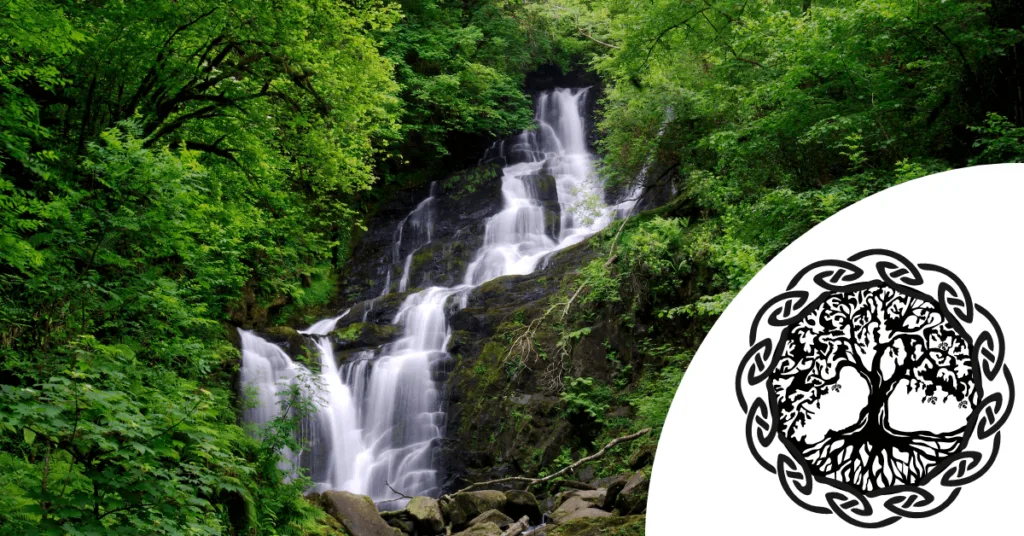
Throughout the world, the tree of life is seen as an important symbol in many cultures.
The Celtic Tree of Life, Gaelic Tree of Life, or Crann Bethadh as it is known in the Irish language, was held in particularly high regard by the ancient Celts.
There is a lot of information about the Celtic symbol Tree of Life online.
Unfortunately, as with nearly all Celtic Symbols, it can be difficult to separate fact from fiction in some cases and many things are disputed. Please be selective of what you read and believe.
(This is one of the most authoritative books on the subject. It is quite in depth and detailed, like all the books in the Aidan Meehan design book series)
What is clear is that trees played a very important role in the lives of Celts.
The Celts believed that trees acted as sacred symbols, were home to their ancestral spirits and could act as doors to the Otherworld.
Trees were also valued by the Celts for their medicinal properties, as well as being life-giving sources of food, shelter and timber.
They were also thought to protect against evil spirits.
Oak trees were considered by the Celts to be the most important of all tree species.
It is therefore no surprise that the sacred tree species shown in the Celtic Tree of Life is an oak.
What is the meaning behind the Celtic Tree of Life symbol?
The most commonly held belief behind the meaning Celtic Tree of Life is that it brings balance and harmony by connecting the different worlds together.
The Celtic Tree of Life symbol depicts an oak tree with its branches reaching up towards the heavens, a strong, stable trunk standing firm and roots that ground the tree into the earth and connect with the Otherworld.
This connection between different worlds is closely associated with the natural cycle of life through birth, death and rebirth and fits with the Celtic circle of life.
The two native Oak trees in Ireland (Common Oak and Pedunculate Oak) bud new leaves in spring, flourish over the summer months and lose their leaves in autumn leaving the trees barren and empty in winter until the entire cycle starts again.
What does the Celtic Tree of Life Symbolize?
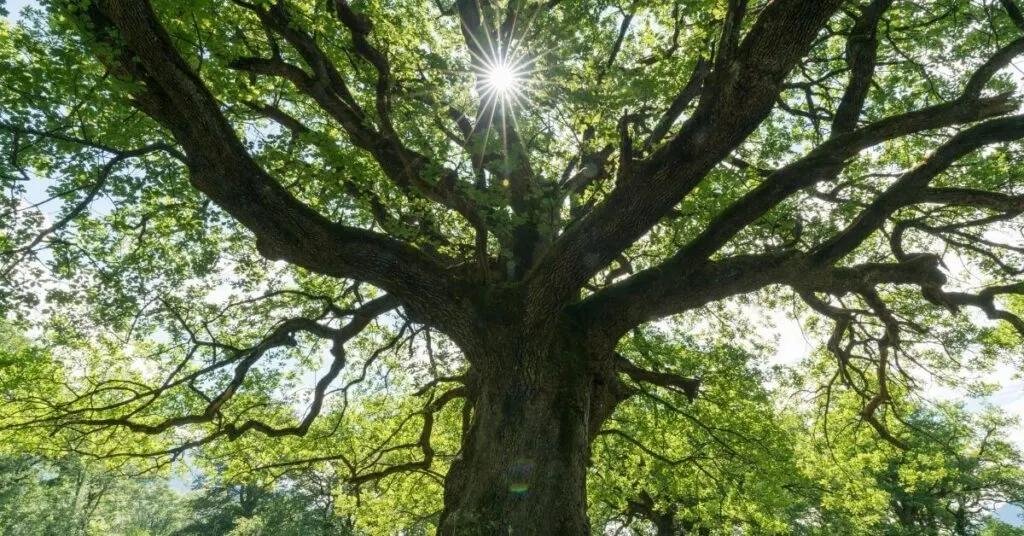
The Celts’ Tree of Life is a very powerful Celtic symbol for strength, wisdom and longevity.
Given the correct environmental conditions, oak trees can live for several hundred years.
Thanks to this longevity, the Celts believe that an oak tree would accrue vast amounts of knowledge and wisdom over its lifetime.
The slow growth of oaks also contributes to the high quality of its timber.
Oak is a strong, hardwood that is heavier and denser than other softwoods. This appealing and valuable characteristic of oaks was revered by the Celts.
There are now many different variations and stylistic interpretations of celtic ancient symbols, including this one. The Celtic Tree of Life is a very popular design for Celtic jewelry.
In the most basic form of the Celtic Tree of Life, the branches are spread wide above the tree stretching up- and outwards and the roots tend to mirror this pattern in the ground beneath the trunk.
Some variations of the Celtic Tree of Life symbol use one continuous line in an interwoven knot pattern to create the Celtic Tree of Life knot.
This pattern symbolizes endlessness due to the fact Celtic knots have no beginning and no end.
So-called Celtic symbols
Not all things that are labelled “Celtic” are Celtic in the true sense.
Here are some commonly seen examples:
Spiral of Life
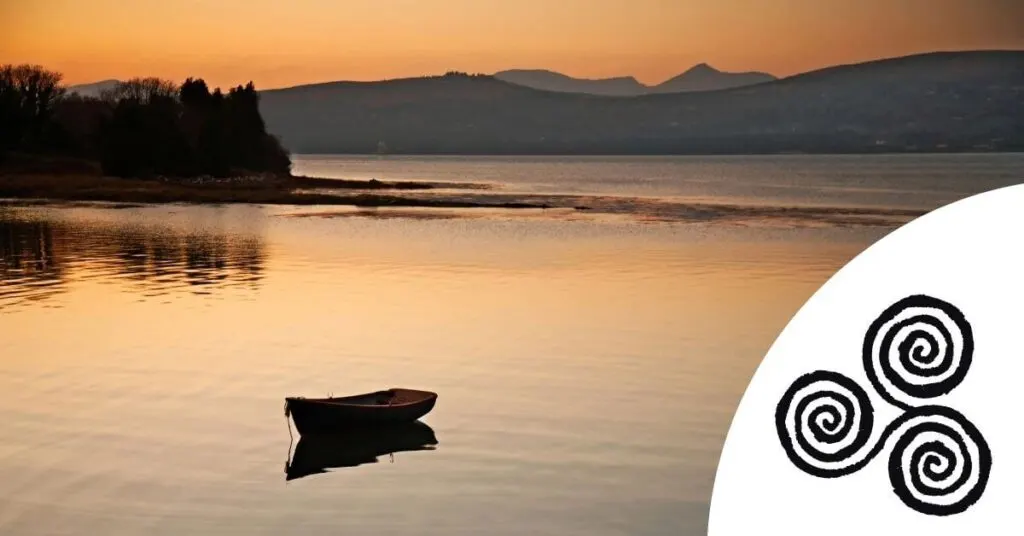
(Photo: © Walshphotos, symbol win win.artlab both via Canva)
The Spiral of Life is often denoted to be an ancient Celtic symbol, but in fact the origin of this ancient symbol predates the Celts.
In fact the oldest record of this symbol is inside the passage of the burial chamber in Newgrange, County Meath in Ireland.
This specific carving dates from the Neolithic Period (ca. 3200 BCE) and was created long before the arrival of the Celts in Ireland (ca. 500 BCE).
It is thought to symbolize the sun, which is of significant importance in Newgrange.
(The tomb entrance is aligned so that sunlight enters the chamber through the passage only on the days around the winter solstice.)
Given the importance of the number three to the Celts, they may have adopted this symbol, or a variation of it, for their own purposes.
Due to its endless design, it has been suggested that this version could stand for the threefold goddess.
Brigid is one of the most famous of the Celtic triple goddesses.
Celtic Cross
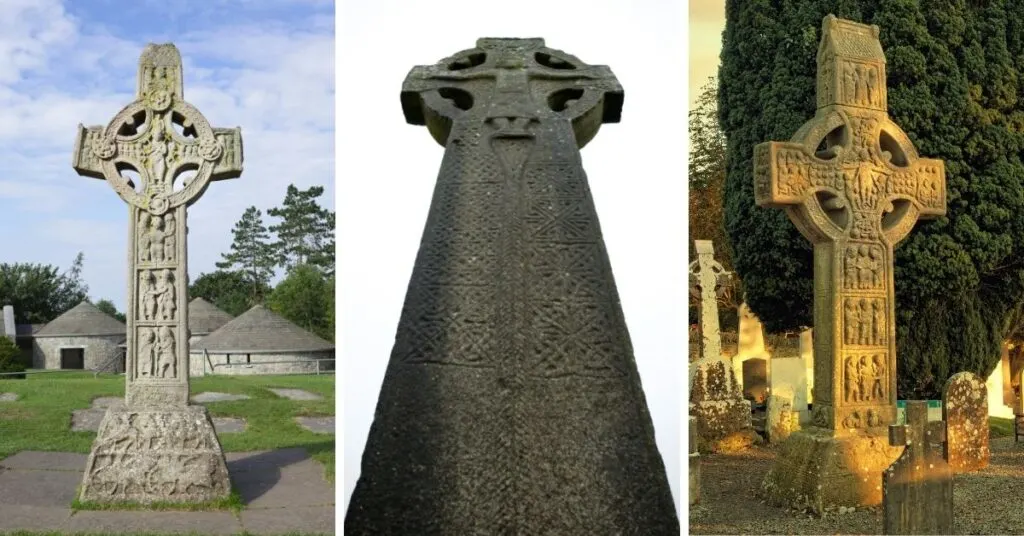
The Celtic Cross, Irish Cross, Celtic High Cross or simply High Cross, as it is most often known, is a very recognisable symbol often associated with Ireland.
However, it is not entirely correct to call it a Celtic symbol, Celtic sign or even a Celtic Christian symbol. It is more accurately described as a Christian symbol that incorporates elements of Celtic design.
A Celtic Cross differs from the usual depiction of a Christian Cross through the use of a circle around the intersection of the cross. It is often ornately carved using Celtic patterns.
These types of crosses are found not only scattered across Ireland, but in other areas where the Celts were prominent, including Scotland.
Most are found in the ruins of old monasteries, such as the Monastery of Clonmacnoise that was founded by Saint Ciaran on the banks of the Shannon in the 6th Century. The Cross of the Scriptures is found at this location.
Another excellent example of an Irish Celtic Cross is Muiredach’s High Cross Monasterboice, County Louth.
Awen
The symbol of the Awen contains three separate lines with wider bases and tapering tops usually encircled within a ring. In some forms there are dots above each line.
It is used in modern Druidism as a symbol for inspiration, but is not an ancient Celtic symbol.
There is sufficient evidence to believe that this symbol was created by the known forger, Edward Williams, who usually went by his bardic name of Iolo Morganwg.
Frequently Asked Questions
This sections will come in useful if you would like to learn more or just have a refresher in Celtic history and art.
Who were the Celts?
The Celts were tribes of people who expanded westward across Europe from roughly 700 BCE. They were a warrior culture with exceptionally good design and craftsmanship skills.
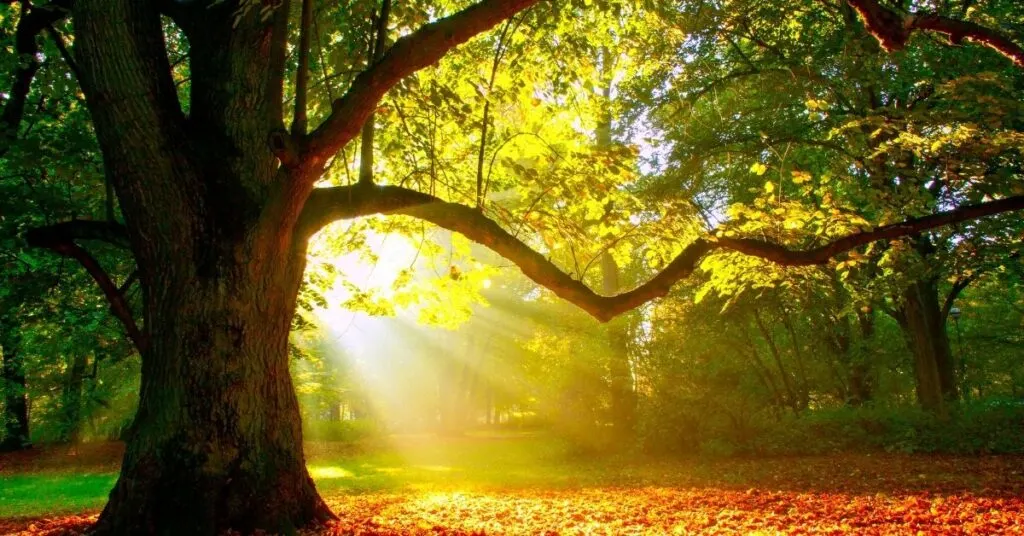
When did the Celts arrive in Ireland?
Experts believe that the Celts arrived in Ireland around 500 BCE at the end of the Irish Bronze Age. from neighboring Celtic areas in central western Europe.
What is Celtic Art?
The influence of Celts and their Celtic artwork can be seen throughout Europe during the pre-Roman times. (The history of Celtic art is quite extensive so this is the bite-sized summary.)
During the La Tène period from ca. 450 BCE to 1 BCE, Celtic artwork flourished. The patterns they created were often inspired by nature and featured geometric patterns, spirals and triskels.
Celtic Insular art (or Hiberno-Saxon art) is from the post-Roman era and refers to the artwork produced in Ireland and Britain. These artworks commonly feature interlace patterns, which is a typical pattern that many people associate with “Celtic Art”.
This style of Celtic art reached its artistic peak in Ireland during the 7th-9th centuries and declined once the viking raids started to take place. It is thought to have extended to about the 12th Century in Ireland.
Intricate interlace patterns are seen in the Book of Kells, which is probably the best example of a manuscript from this time.
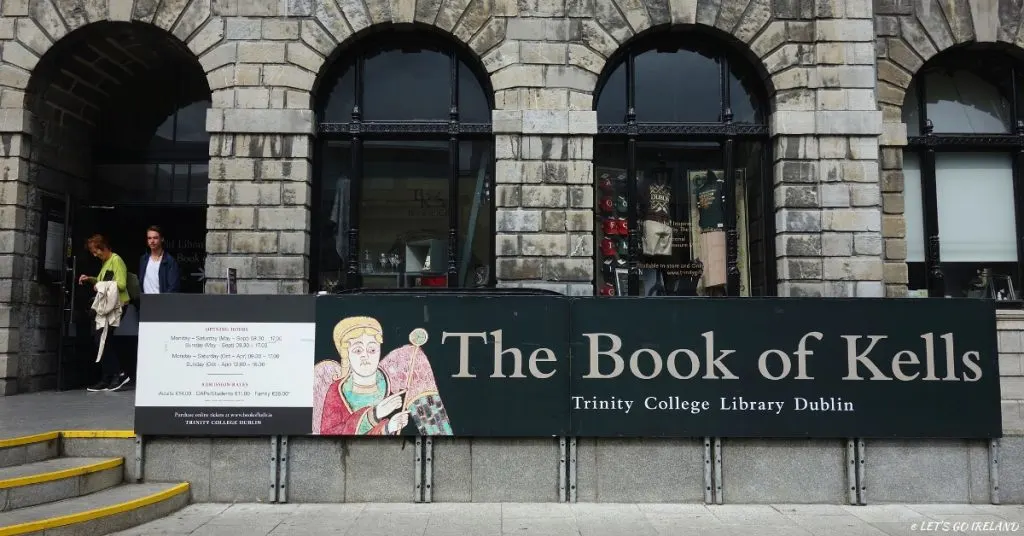
Is it possible to accurately interpret the meanings of Celtic Symbols?
Celtic traditions and knowledge were passed down by word of mouth from one generation to the next.
Even druids, who were thought to have been literate in some cases, did not leave written accounts. This is probably because they were forbidden to do so.
Without written sources it is difficult to verify whether the traditions and symbols Celtic that people created may have changed or have lost their original meaning over time.
The meanings behind the symbols that are given today are based on the research and guesswork of scholars.
For example, the late artist George Bain was a pioneer in untangling the intricacies of Celtic art and knotwork in the mid-20th century.
It is worth keeping in mind that many of the meanings behind Celtic symbols were only attributed relatively recently during the Celtic Revival (in the mid-19th century).
There is a vast amount of information available on the subject of Celtic symbols online. However, the large majority of information about Celtic Symbols available online tends to be either not true or not entirely accurate.
For example, if you were to believe everything you read, you would think that there is a Celtic symbol for new beginnings (which there is not).
Please remember this and be critical of the information you read, even from so-called “reputable” websites (especially if you are searching for a Celtic symbol tattoo).
With this in mind, we would like to state that this article has been researched to the best of our abilities.
For further reading on this subject, please check out the following:
- Spirals and Vortices: In Culture, Nature and Science, Eds. Kinko Tsuji and Stefan C. Müller – Interesting information about the origin of spirals
- The Methods of Construction by George Bain – A slightly dated, technical guide about how to draw Celtic designs. (It is not for beginners, but interesting for people who like the subject.)
- The Celtic Design Book by Aidan Meehan – This is a useful artistic guide about Celtic designs and meanings.
Looking for Celtic Knot Tattoo and Celtic Symbol Tattoo Motifs?
One of the most popular reasons people research Celtic symbols is when they are looking for Celtic tattoo ideas.
The decision to get a tattoo is a very personal one. Aside from aesthetic reasons, there are many other grounds why people opt for Celtic tattoo designs.
For some people, celtic knot tattoos may enhance the connection to their Celtic heritage.
Others may search for the Celtic symbol for strength or the Celtic symbol for inner strength in the belief that it may help their own resilience.
Family members are also often the motivation behind Celtic symbol tattoos with Celtic knot for family, the Celtic symbol for mother and son and the Celtic symbol for mother and daughter being popular.
Others may identify with a Celtic Cross tattoo as a representation of their faith.
Whatever the reason, it is important to know that a lot of information online about Celtic symbols and Celtic knots is not true or accurate.
As the Celts did not keep written records, the meanings behind the symbols cannot be completely verified and are largely based on interpretations.
Some of these interpretations have been made by scholars who researched the available facts and knowledge of Celtic culture and customs.
Other interpretations behind the meaning of Celtic symbols come from less reliable sources.
It is worth investing time before getting a Celtic design inked on your body that the symbol, word or phrase used is the celtic knot tattoo meaning that you want and expect.
This book may be of some help if you are looking for exact and relevant translations of English words and phrases into the Irish language.
Although it does not focus on Celtic designs, it is related and does give useful insights into Irish and Irish expressions.
Whatever the reasoning behind getting any tattoo, be sure to do your research before getting something inked on your body.
Find out more about Celtic Knot designs here.
Interested in finding out more about Ireland and its Celtic heritage?
If you would like to see ancient Irish metalwork and Celtic design, then a trip to the National Museum of Ireland for Archeology is a must.
Find out more about it and other things to do in Dublin here.
This post may contain affiliate links. If you click on one of them, we might receive a small commission (at no extra cost to you). Thanks for your support!

(Irish and Celtic Culture Aficionado, Literature Buff)
Nils Beese co-founded LetsGoIreland.com driven by his love for Ireland’s rich culture and captivating Celtic traditions. Holding a PhD in Irish literature, he’s spent time in Dublin and Cork, immersing himself in local tales and traditions. As a lecturer and guide, Nils seamlessly blends his German roots with his deep appreciation for Irish and Celtic culture. Through his writings, readers are invited into the vibrant and enchanting world of Irish stories and Celtic lore.
